Avial recipe (or Aviyal) is one of the first recipes I shared on Edible Garden but since then, I have perfect the technique to make avial just like we do back home in Kottayam and I wanted to revisit this Onam Sadya essential. Every Avial recipe has many variations since it’s a South Indian recipe and even within Kerala, it’s made in a few different ways.
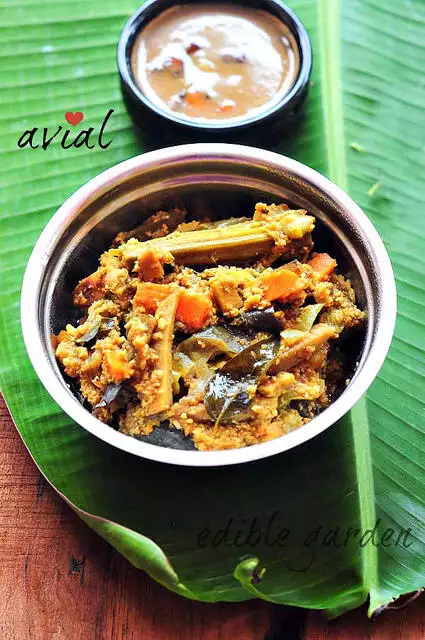
Personally, I prefer the semi-dry avial recipe that Amma uses without adding curd. We add sour raw mangoes for tartness and that works perfectly without making the avial too dilute or watery. This is probably the South Kerala style of making avial. Like many dishes around the world, avial was born out of the need to use up leftover vegetables, I am sure. There are many different variations to avial recipe like this raw cashew avial, tomato avial, and the more popular mixed vegetable aviyal. We generally use the same list of vegetables but it’s ok if one or two of them is missing due to seasonality or non-availability.
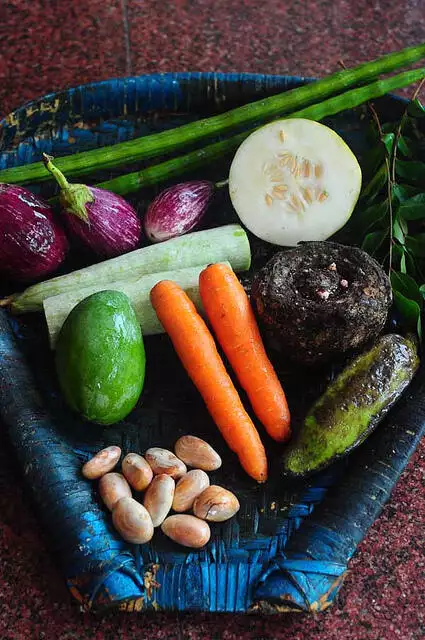 |
| Vegetables for Kerala Avial |
I must, however, mention that the fresher the vegetables, the better. I once made avial with a frozen bag of vegetables and it was just average-tasting although my coconut was fresh. Using a mix of frozen and fresh vegetables, whatever is available where you live, is better than using just a bag of frozen ingredients for this dish.
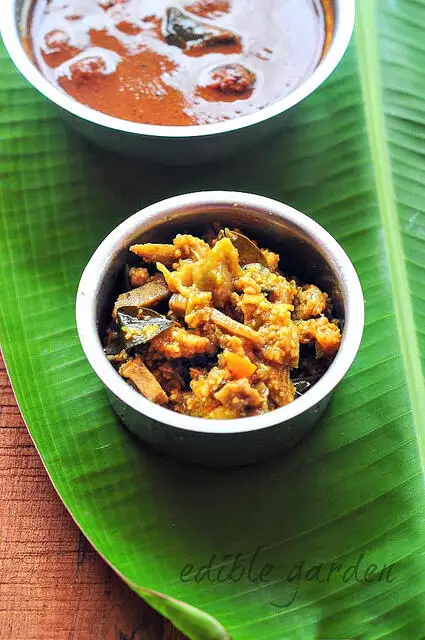
Here’s an almost-complete list of Onam Sadya Recipes in case you planning an Onam sadya this year.
Preparation notes: It’s important to cut the vegetables in similar length and size for even cooking. Generally, the vegetables are cut into 3″ long 1/2″ wide strips and cooked in a staggered manner, clubbing the ones that have same cooking time together. I have referred to them as “strips” in the ingredients list. have also added more details on cooking time in the instructions below.
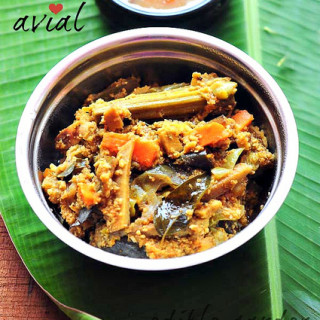
Avial recipe Kerala-style
Ingredients
- 1/2 cup of carrots strips
- 1/2 cup of snake gourd strips
- 1/2 cup of brinjal strips
- 1/2 cup of raw banana strips
- 1/2 cup of jackfruit seeds quartered lengthwise
- 1/2 cup of elephant yam strips
- 1/2 cup of old cucumber strips
- 6 3 " long drumstick pieces
- 1/2 cup of raw mango strips
- 2 cups of grated coconut
- 1 tsp of powdered jeera cumin, jeerakam
- 1 tsp of red chilli powder
- 2-3 green chillies
- 1/2 tsp of turmeric powder
- 2 tbsp of coconut oil
- A few curry leaves
Instructions
- Add all the cut vegetables except mangoes to a large cooking pot (we use the traditional kal chatti or stone pot to make avial at home).
- Top off with half the turmeric powder, cumin, curry leaves, and chilli powder.
- Add about 1/2 to 3/4 cup water and mix well.
- Cook covered on a low flame for about 10-12 mins or until the vegetables are cooked yet hold their shape.
- Take care not to cook them to a mush, I would suggest checking every 5 mins to confirm this.
- Meanwhile, grind together - coconut + green chillies + remaining turmeric + some more curry leaves to a coarse paste without adding water.
- Check that your vegetables are almost cooked.
- They would have let out a fair amount of water while cooking and this is good.
- Add the ground coconut mixture on top along with requirement amount of salt and the mango strips.
- Without mixing, cook covered for another 3-4 mins.
- Almost done! Mix the coconut mixture in gently and remove from heat.
- The avial will be a bit watery still but it will dry up as the vegetables absorb it as they sit.
- Drizzle the coconut oil on top and mix gently.
- Set aside covered loosely for an hour before serving.
Step by Step Kerala-style Avial Recipe:
1. Add all the cut vegetables except mangoes to a large cooking pot (we use the traditional kal chatti or stone pot to make aviyal at home). Top off with half the turmeric powder, jeera, curry leaves, and chilli powder. Add about 1/2 to 3/4 cup water and mix well.
The vegetables we used have more less less the same cooking time except mangoes which cook much quicker. So we add them later when adding the coconut mixture.
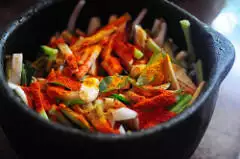
2. Cook covered on a low flame for about 10-12 mins or until the vegetables are cooked yet hold their shape. Take care not to cook them to a mush, I would suggest checking every 5 mins to confirm this.
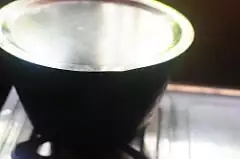
3. Meanwhile, grind together – coconut+green chillies+ remaining turmeric+some more curry leaves to a coarse paste without adding water.
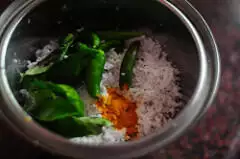
4. Check that your vegetables are almost cooked through. They would have let out a fair amount of water while cooking and this is good.
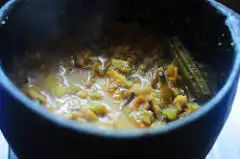
5. Add the ground coconut mixture on top along with requirement amount of salt and the mango strips. Without mixing, cook covered for another 3-4 mins.
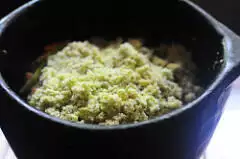
6. That’s it! Mix the coconut mixture in gently and remove from flame. The avial will be a bit watery still but it will dry up as the vegetables absord it as they sit. Drizzle the coconut oil on top and mix gently. Set aside covered loosely for an hour before serving.
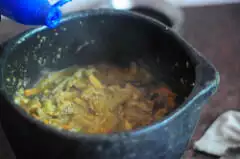
Notes:
- If you don’t have raw mangoes in hand or they are not sour enough, you can add 1 tbsp tamarind water or sour curd. Mangoes lend a much better flavour to aviyal though
- Note that avial is not tempered so it’s important to add the oil at the end
- It’s important to cook the vegetables in a low flame so as to retain the moisture level and so that it doesn’t start burning from the bottom
- You can adjust the amount of coconut to your preference
- Our version of Aviyal is a no-onion no-garlic recipe
For avial recipe in Malayalam, Tamil, Hindi, Urdu, Kannada, etc please use the Google translate button in the sidebar.

Thanks for this one too. It was magic!
Yay!
Looks yum…. where did u get the pot in which u cooked the vegetables it looked different from normal earthen pots…
this is actually a stone pot (kal chatti) that’s popular in the southern parts of Tamil Nadu. Needs seasoning and this particular one you see is over 30 years old.
Good
Good one..we never used red chilli powder.using crushed ginger Nd green chilli s…
Thank you for the recipe.
Avial was tasty
thank you!
Hi am sana